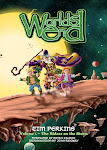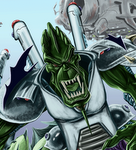Is the pamphlet format dying and being replaced by a bookshelf upstart?
Well this has been a topic on many folk’s agendas lately and so I thought I would add my two-penneth.
Personally I think it is, but the publishers are doing this to themselves.
Firstly the comics are expensive in comparison and the story is broken up, understandably so, by advertisements. If this weren’t the case then the cost would obviously rise once again and astronomically too! The shelf life of comics is extremely limiting, whereas the graphic novel’s shelf life is as long as folks want to continue buying copies of it.
As I see it the multi-versions of a character out per month make collecting any of the other comics by a particular company hard and this is down to the expense, let alone the ability to afford any other company’s fare. Also the time span between a comic story arc being published and then released as a trade paperback is getting less and less and writers are even beginning to write comic books in chapter form so they fit the graphic novel (or rather trade paperback) format.
As a result of all these traits the comic collector is becoming less and less likely to buy the comic version and instead wait for the book length collected version, which often has extra pages of story or a sketch book section and a cover gallery included, much like many DVD’s with their extras sections.
This is especially the case if a comic collector misses an early issue of a story arc or mini series.
The way I see things working in the not too distant future, unless the publishers wish to bury comics completely is this:
Put out a maximum of two comics by any of the popular character(s) per month.
Don’t reprint them – at least not any time soon.
Print them on cheaper paper, much like they used to be and make them affordable and street-cred for the kids to read them.
Also make them a throw away product…let’s see the kids rolling them up again in their back pockets, instead of buying copies, hording them in acid free Mylar bags with backing boards, hidden away in boxes, in airtight containers away from the light…
GUYS THEY ARE MEANT TO BE READ AND LOOKED AT!!!
Get the comics back out into the mainstream market place as well as in the direct sales market place.
Originate new work as graphic novels, not trade paperback reprints.
Yes, this will have repercussions on the cost of originating these, but what the ecch…if the market is to survive, things have to change.
This way the graphic novel doesn’t have to replace the comic book – no instead it is a progression from the comics for the kids.
All the doom and gloom of the comic industry over the past ten to fifteen years has to stop, for goodness sake!!! We were being told the industry was dead in the mid-nineties, following the comics crash of 1994…well that was wrong, now let’s prove them wrong again!!!
Go out folks and buy ONLY the comics you like and follow this up with buying the collections you maybe missed first time around, or no longer have them in your collections and look at the new “originated” graphic novels.
There is room for all of the formats…
But the old way of selling them needs to be re-found…or at least reinvented!
Let’s get them back out as annuals too…
Like I said a few posts back…
“The times they are a changin’” and like Jack said again it’s going to happen…”in the world that’s coming!”
Until next time have fun!
Tim Perkins…
March 15th 2007
The End.
4 years ago












































1 comment:
Nice blog Tim! I've never been keen on the term "Graphic Novel" but I'm equally uncomfortable with the more recent use of the word "pamphlet" to describe comic books. After all, comics have been 32 pages since the 1950s (or even late 1940s) but we never called them pamphlets until recently. ;-)
As for modern comics, a cheaper format, non-glossy stock, anthology format and more pages might entice new readers. But as long as the specialist market dominates publishers thinking they'll keep on pandering to the fanboys and their preference for style over content.
Lew
Post a Comment